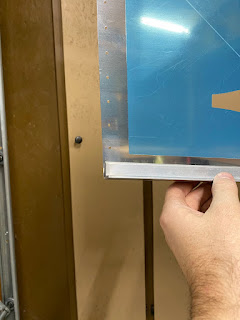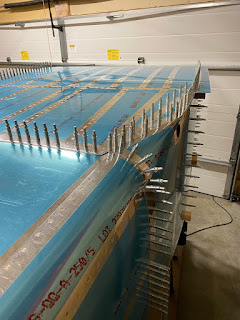I am finally on holidays from work....Yeehaww. But the stress has not subsided yet. I have to get these conical bends on the F-770 side skins done first. I've been reading lots on how best to do this and avoid cracks. Really at the end of the day...The opinions are all over the place so pinning the exact best procedure down is not easy.
Two items that have really stood out in my mind as being critical are:
- Polish up that relief hole before you bend. As I learned on dimpling the fuel tank skins...It is absolutely critical for success to get those holes clear of all deburring marks and tooling marks. Those cause stress risers which caused cracks to form when dimpling for the screws. Best method I have found was 800 grid sand paper on the shank of the dremmel. Then some maroon scotch brite (1" square) on the dremmel to polish the edges of the hole.
- From working on Mike's S-51 mustang I learned that you must have bend radius when bending aluminum. The thicker the aluminum, the larger the radius. So seeing guys bending the conical bends on the sharp edges of their back riveting plate caused me some concern. I was going to use a bend radius.
- I think everyone's opinion of get the bend done in one fluid motion is key. Don't bend, relax, bend relax.
Its fairly easy to put a radius on my back riveting plate. My back rivet plate is huge (I bought scrap 3/8" flat bar from the steel yard and made my own). So it doesn't matter if the bottom side has a rounded side. I pulled out the angle grinder and slowly worked the side edge of the back plate down to a small radius fillet. Using 100 grid sandpaper on the palm sander, I rounded the edge. Took some time....But I'm happy with the result. I have a nice solid edge with a small bending radius.

Next I needed to figure out the bend line. That took a bit of research to sort out but in the end, its not entirely critical where the aft line ends up....The front must align with the relief hole.


Next I fabricated the aluminum angle (0.125x 3/4" x 3/4" x ~12 to 14") that I was going to use to bend the skin.


I learned some things here that nobody really talks about. I fabricated the angle to fit right down to the relief hole and then trimmed the top of the angle flange back to clear the bend line plus ~3/8" thinking I need space to clear the back plate when riveting. I rounded all the edges and made it perfect. Then I looked over the pictures that Van's provides at the back of the instructions. It was very curious that n the Van's pictures, that bending angle is actually set one rivet hole back from the relief hole. After thinking on it for a while....
I too moved the angle back one hole (as you will see in my bending pics). It turns out that it gives you proper clearance and it doesn't not affect the bend...It still get pretty tight at the relief hole.
Before bending....I broke all edges with a file, cleaned up the shear marks and then smoothed it all out with the 3M wheel. The relieve hole was opened up slightly with a fine small diameter chainsaw file enough to get my dremmel with the 800 grit sandpaper in there. I then polished all edges up.
I set up...Ready to bend. Notice how my angle is set aft one rivet hole from previous pictures....

I started the bend, ensuring it was done in one fluid motion. I did stop halfway through as I need to change the position of the vice grip but I held pressure on the bend with my hip until I could change vice grip position. I then finished the bend. I used my thumb to put pressure on the tight bend while twisting the vise grip at the other end. It turned out extremely well. Side point - The 1 1/2" hole for the side steps look just fine...Did not have an adverse effect on the bend at all.


I then made adjustments to the large bend to fit the curve of the aft fuselage.
When
it looked right, I used the edge forming tool on the aft ends of the skin and
conical bend. Next I clecoed the side skin on.



















































